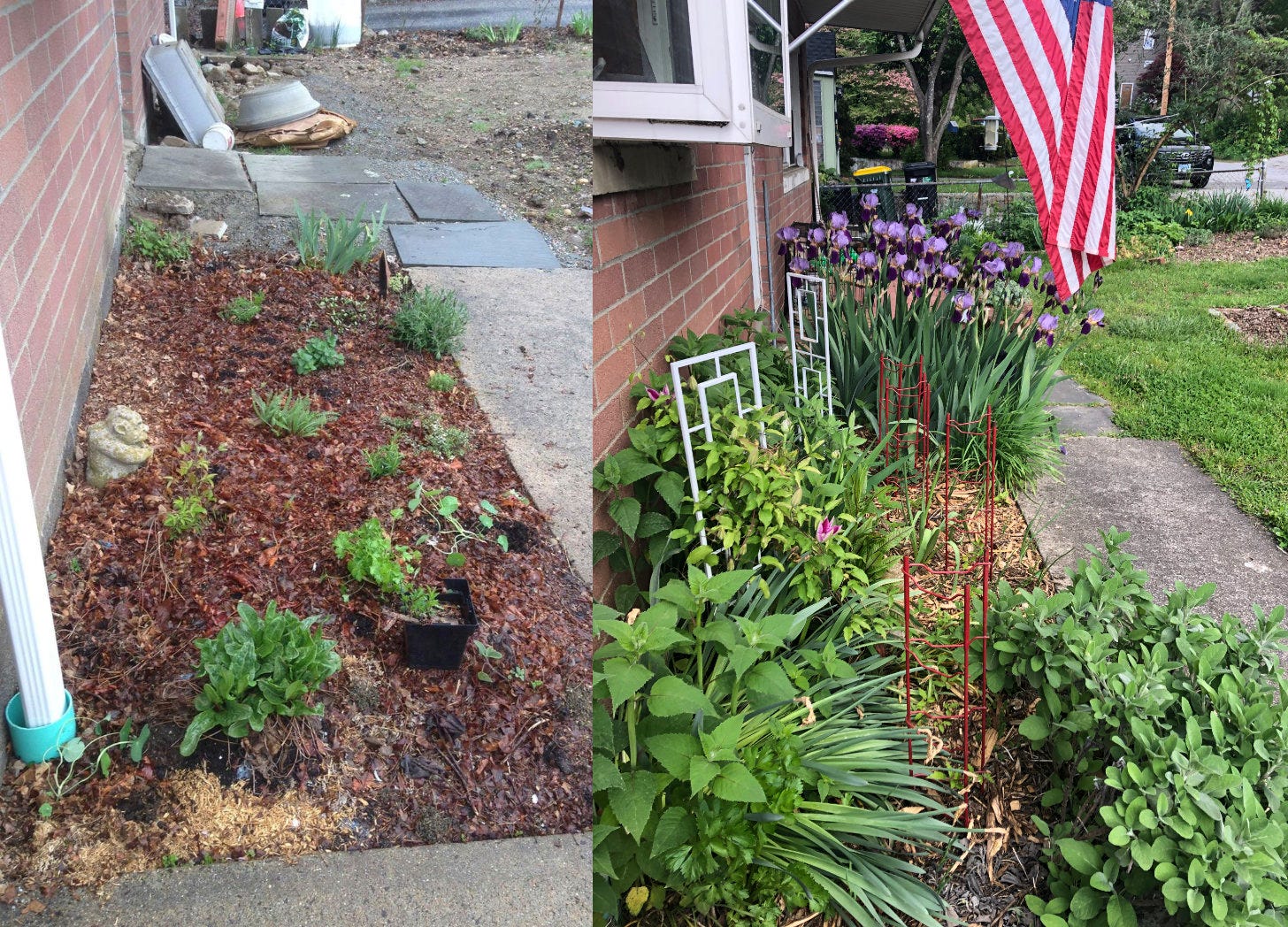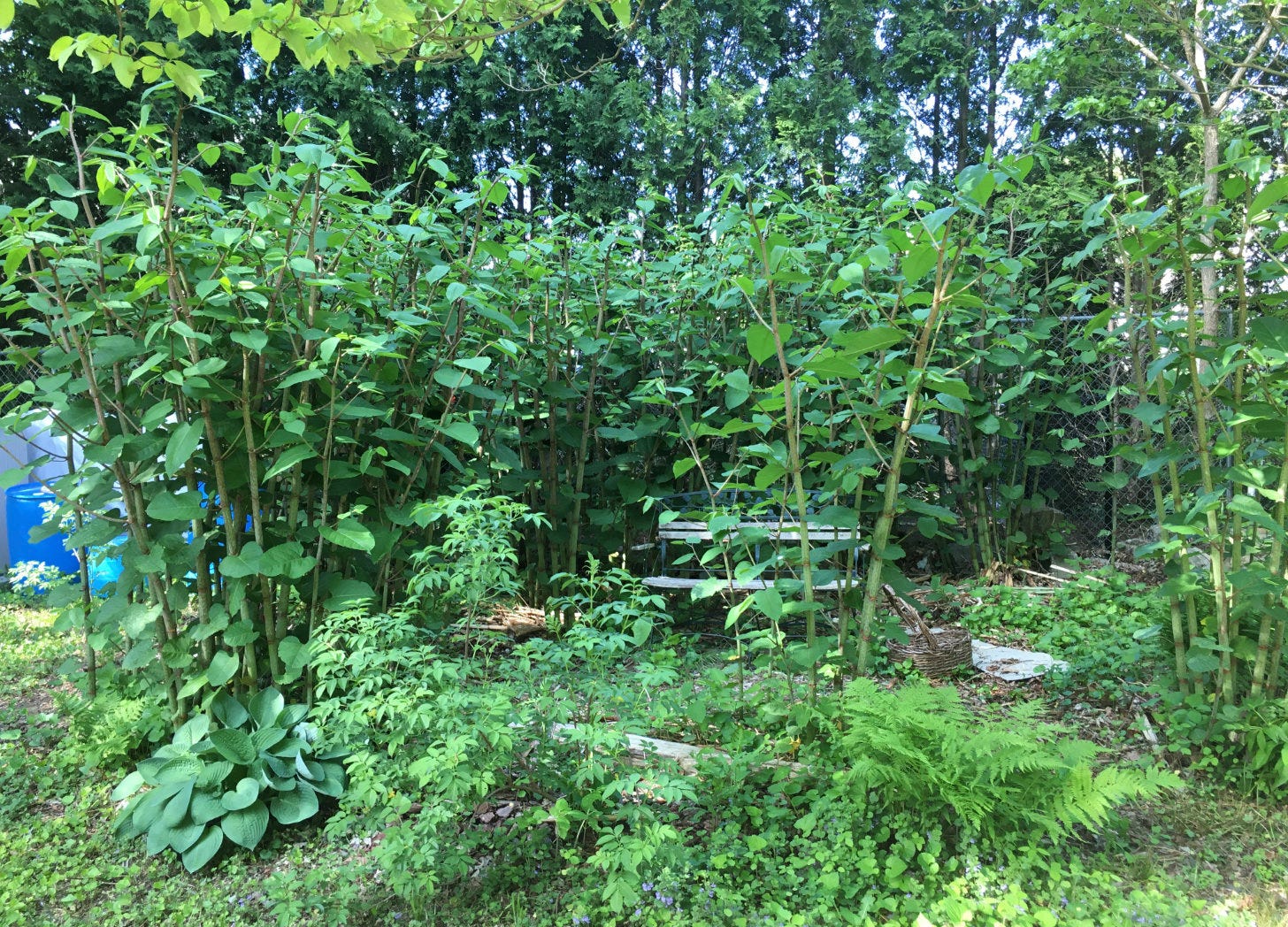We bought an unoccupied property in 2016. The bottom end of our new yard was filled with Japanese knotweed. In case you don’t know what that is, let me explain. It’s a type of bamboo, but with thin, mostly hollow stems that break easily, and big heart-shaped leaves that block out sunlight. The 6’-12’ stalks bend over, shading out surrounding plants. Nothing can live under the canopy but ferns, and that’s only at the edges. There were no more than ten different plants in the backyard. There wasn’t even much animal life except for the bees in the fall when the knotweed bloomed.
Mine was an old patch. The stalks were one and a half inches around [the roots were about the same as I found out later.] The patch was 12’ high, and 30’ wide by 12’ deep. It was enough to make a gardener scream. This plant is invasive as Hades. The roots can go over six feet deep, and since the plant evolved around places where there are volcanos, they can grow 35 feet underground looking for a place to pop up from under a lava flow. Getting rid of it is hard and usually requires carefully applied herbicides.
It was happy in my yard. It had claimed a low spot where the sun got through the trees. While there were a few small stalks that had reached away from the main clump, the yards around me were all shaded and my monstrosity had claimed the only sunny patch available. Its energy was heavy, dark, cool, and still. It was also serene, confident in its survival. Like many Pagans/Witches, I could hear it, feel its roots pulling water from the soft dirt.
In his book God is Dead. Long Live the Gods, Gus DiZerega talks about how the argument for the existence of god was large in monotheism, but non-existent in polytheism. We feel our gods, and other beings in the unseen world as well. DiZerega describes Plato having a vision and quotes from Phaedrus.
There is also a madness which is a divine gift, and the source of the chiefest blessings granted to men. Poor prophecy is a madness, and the prophetess at Delphi and priestesses at the Dodonna when out of their senses have conferred great benefits on Hellas, both in public and private life, but when in their senses few or none. And I might also tell you how the Sibl and other inspired persons have given to many information of the future which has saved them from falling. But it would be tedious to speak of what everyone knows. [Italics mine]
There was nothing strange for the ancient Greeks about being possessed by a nymph so the nymph could convey an idea. For modern Pagans, communicating with the unseen world - or plants, rocks, and fauna - is normalized when we gather. The longer we can stay, the more relaxed we feel, and the more insight we gain.
Then we have to go back to a world where such things are an implication of insanity, or even evil.
However, there are a few places where insight is accepted with wink, and even respected. Gardening is one such. Our ancestors grew food. The ability to do that well was - and is - a critical skill. Industrial farming is something else entirely. I think most people who practice some form of non-monotheistic, earth-centered religion are aware of the hot mess that is our food production system. [Yes, it has had value in feeding the rising billions, but now we need to think about producing food that nourishes both humans and the soil or it won’t keep working.]
I was determined to have a garden. Once I discovered permaculture principles, I grew food even in our tiny yard [the property was 1/10th of an acre.] This new-to-us house had more space, although the front yard got completely torn up after we bought it [plumbing issues]. The backyard was lined with old cedars and hemlocks, the knotweed claiming what was left of the sun. After we bought it, I tackled the tiny patch of soil under the kitchen window and then concentrated on the living areas so we could move in. The knotweed could wait. It had been there for decades. A few more years wouldn’t matter, and the bees loved the flowers in the late fall. I put a bench among the tall stalks so I had a place to sit in the deep shade on a hot afternoon.

One of the principles of permaculture is observation. I didn’t yet know this property. I didn’t know the angles of the sun, how the water flowed, what plants were here already, and what kind of soil they lived in. I didn’t know if a conscious guardian spirit inhabited the place. Until I knew those things and connected with it, any fixes I applied would be just as sterile as the knotweed. Besides, my life was chaotic with a rolling crisis.
While I was wholly opposed to the 2020 lockdowns beyond the first two weeks, that, and another big change gave me both time and incentive to consider the backyard. I’d moved my gardening efforts from the community garden plot to my front yard, which had full sun. The downside was that there was no decent soil. The early plumbing problem meant the front yard was all subsoil and building good topsoil would take a few years. The good soil was in the back under the knotweed. It was rich and dark and soft.
I began tracking the hours of sun all around my house. My husband and I took down three dead or dying cedars, and an autumn olive, another invasive species. This meant more sun. I noted that the knotweed was at the bottom of a dip. If I ripped it out, where would the water go? How could I make that work? The answers came slowly, gently. This land had no guardian. The property had been unattended for decades with nothing but the intruder to occupy it. Offering attention wakes up the unseen world if it’s been sleeping.
I wanted a permaculture garden. A place that would have a wide variety of perennials. I wanted a fruit tree, some berry bushes, beds for annuals [including food plants] and lots of flowers. A wider variety of plants would attract more insects. More insects meant more birds and small animals.
At the end of 2022 I apologized to the knotweed and began digging. [I’m pretty sure it laughed at me.] I didn’t try to do it all in one day. But every afternoon in September and October I went outside and dug out a clump or two of the knotweed by its massive roots. But I didn’t stop there. I dug down 18” extracting brittle shoots. I collected wood from people who had cut down trees and buried them where the knotweed had been. This would soak up water and release it slowly so I didn’t have a big soggy spot once the water-loving knotweed was gone. I put down layers of cardboard and built raised beds on top. I planted a pair of dwarf apples, and my husband and stepson put up a stockade fence.
The apple trees were quite different. One was quite chill. The other [a Wolf River] was anxious. I spent a great deal of time speaking gently to her [definitely female]. She was worried the elderberry planted nearby would smother her or shade her out. [I assured her I would trim it if it got too close.] She was in front and would eventually be creating the shadow. When the remaining roots of the knotweed began sending up shoots, she wanted them to dry out and rot around her trunk. Deep-rooted plants pull up minerals and those seemed good to her. I asked both trees which plants I had in the front yard they might like as companion plantings. Wolf River has yarrow, catnip [currently being decimated by my cats] and red clover.
There are now over 40 different kinds of plants where the knotweed one stood. That doesn’t include the annual food crops in the raised beds but does include the shade plants in a little rock garden. Last year was quiet with all the perennials getting settled in and a ridiculous amount of rain. We had so much rain that there was a river running down my driveway more than once. It went straight to the garden making an ankle-deep pool. The pool was gone within 15 minutes. It’s late May now of the second year of the garden. There are butterflies flitting around, bumblebees in the comfrey, and tons of birds. Chipmunks have moved into the brush pile [first time I’ve seen a chipmunk here] and I even saw a garter snake last week.
When I sit out here to write, I feel the life around me. Moving through me. I hope a nymph might settle here. I can wait. In the meantime, my neighbors love my front flower garden, and offer me fun things like wrought iron decorations and paving stones to embellish the new space.
The knotweed is trying to come back. [not shocked] I pull it up, using a trowel to get as deep as I can. It might take a few years, but eventually, the roots will starve. I’m patient. It’s not laughing anymore.
Selina Rifkin, M.S. [Nutrition], LMT, has been to Hades in a handbasket. More than once. This has given her some opinions. She has direct communication with her gods and they’ve always given her answers when she asks. Like most of her generation [X] she’s okay with snark. Most days she tries for good writing. But the snark, and side comments creep in. Be warned.








This was such an amazing piece on so many levels. I loved the gardening information, and I loved it that you allowed the earth and land as it was to speak to you before you bulldozed your way in with an already defined plan (pretty much my usual, which I am now re- thinking). A truly joyful and illuminating read- thank you for sharing!